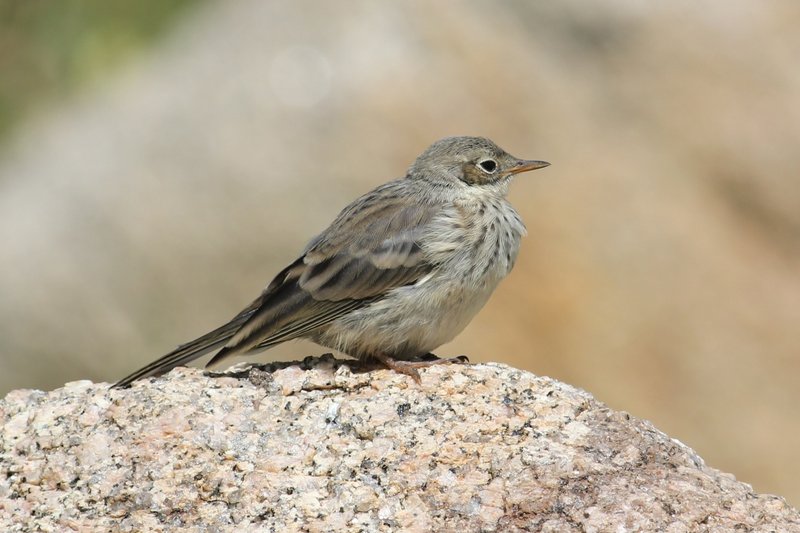Fall is the best time to see one of Maine’s rarest breeding birds, the American Pipit. The only place in Maine where these ground-dwelling birds nest is on the Tablelands leading up to Baxter Peak on Mt. Katahdin. Seeing these unusual breeders on a hike up Mt. Katahdin is a welcome bonus to a hiker with a birding interest.
American Pipits do have a broad breeding distribution across North America, mostly in areas that are inhospitable for these insect-feeders in the winter. They nest across the North American tundra, in most parts of Alaska, and along the crests of the Rocky Mountains and Cascade Mountains, nesting as far south as Arizona. They also nest broadly in Newfoundland. Migrating American Pipits pass through Maine in significant numbers.
American Pipits belong to the bird family called the Motacillidae, a family that also includes wagtails (much more common in the Eastern Hemisphere). All motacillids spend most of their time on the ground foraging for insects, spiders and even freshwater snails and crustaceans.
The Motacillidae includes about 65 species of birds. Forty are classified as pipits, which are more cosmopolitan than their wagtail relatives. Most pipits are found in the Old World but also occur in North America, New Zealand and other oceanic islands.
Pipits are generally inconspicuous birds whose brown, buff and gray plumage provides great camouflage against stony ground. The bill is pointed as one expects for an insect-eater but not as fine as the bill of a New World warbler. The breast of most species is streaked, affording yet more camouflage.
The American Pipit can be distinguished from other ground-dwelling songbirds by its habit of bobbing its tail as it walks. The outer tail feathers are white and are conspicuous in flight. The call of a pipit, often given in flight, is (you guessed it) a two-noted sound described as “pip-it”. Here is a link with sound files: http://tinyurl.com/m4ssm6a
Before 1989, North American field guides gave the name of our pipit as Water Pipit, which showed a broad distribution throughout North America and Eurasia. But the American Ornithologists Union Check-list Committee split the North American forms from the Eurasian forms, elevating our birds to a separate species — the American Pipit — restricted to the New World.
So how do you see an American Pipit short of hiking Katahdin or visiting the Arctic tundra in the summer? Migrating American Pipits often occur along beaches, so areas like Reid State Park can be productive. They also occur in agricultural fields, particularly in those where farmers spread manure. As their former name suggests, American Pipits often forage in wet fields and near freshwater water bodies. American Pipits will wade into shallow water after aquatic invertebrates.
American Pipits are social creatures during migration, so seeing a solitary individual is unusual. Scanning fields for pipits will often yield Horned Larks and Lapland Longspurs, two other passage migrants that are mainly ground-dwelling birds.
If you get a close look at an American Pipit, take a look at the claws on its toes. Those claws are exceptionally long, particularly the one on the hind toe. This characteristic of long toenails occurs convergently in other groups of birds that spend a lot of time walking on the ground. Horned Larks show similar long toenails.
The long claws may aid American Pipits in walking on snow, but deep snow cover will usually push these birds south as the weather in northern areas deteriorates. American Pipits winter along the southern tier of states from California to Florida. Along the east coast, some pipits will winter as far north as coastal Virginia. The Mediterranean climate of the west coast of North America permits American Pipits to overwinter as far north as western Washington and even southwestern British Columbia.
Herb Wilson teaches ornithology and other biology courses at Colby College. He welcomes reader comments and questions at:
whwilson@colby.edu
Send questions/comments to the editors.



Success. Please wait for the page to reload. If the page does not reload within 5 seconds, please refresh the page.
Enter your email and password to access comments.
Hi, to comment on stories you must . This profile is in addition to your subscription and website login.
Already have a commenting profile? .
Invalid username/password.
Please check your email to confirm and complete your registration.
Only subscribers are eligible to post comments. Please subscribe or login first for digital access. Here’s why.
Use the form below to reset your password. When you've submitted your account email, we will send an email with a reset code.